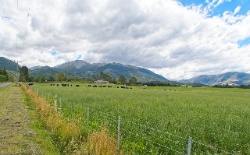Federation Launches ‘10 In 10’ Campaign
7 November 2006
Federation Launches ‘10 In 10’ Campaign
Federated Farmers has launched a campaign aiming to help individual farmers reduce their farm’s environmental impact through nutrient loss by 10 percent over the next 10 years.
President Charlie Pedersen launched the “10 in 10” campaign at Federated Farmers’ National Council meeting in Wellington.
“I want every Federated Farmers’ member to commit to reducing their farm’s environmental impact, in the form of nutrient loss, by 10 percent over the next 10 years – ‘10 In 10’.
“Without a doubt this is a challenge but it represents the direction farmers are heading. We are confident we that we have, are, and will continue to do our share to improve the environment.
“With the Federation’s proven information networks and with improved linkage with scientists and researchers, ‘10 in 10’ can be achieved,” said Mr Pedersen.
For more information about ’10 in 10’, read Charlie’s speech at www.fedfarm.org.nz
--
FEDERATED FARMERS OF
NEW ZEALAND (INC)
Charlie Pedersen
President,
Federated Farmers of New Zealand (Inc)
Address to
National Council
10:10 am, 7 November, 2006
Te
Papa, Wellington
Welcome to your National Council
meeting.
Under our constitution, this council is the highest decision-making body of the Federation.
Your time here over the next two days is highly valued and much appreciated by the membership.
On behalf of members, thank you for attending this important event in the Federation’s diary.
The 40-member council comes together this time every year to set the future direction for the Federation, to approve our budgets and strategy, discuss topical events, and hear from relevant speakers.
The last time I spoke to you was at our annual conference in July.
You will know that my speech at that conference touched off much debate because it dared to criticise the misguided actions of extreme environmentalists.
Some of the misinformed debate following my July speech formed the basis of my second speech on agriculture and the environment, which I made at the Wellington Club in September.
In that speech, I addressed some of the myths around farming and environmental sustainability.
One of these myths is that farmers do NOT care about the environment and are NOT worried about the downstream effects of farming.
I want to re-iterate for the benefit of those who haven’t been listening that farmers DO care about the environment and they ARE concerned about the downstream effects of farming on the environment.
However we don’t need to feel too embarrassed, as cities and towns modify and influence the environment far more than farms ever have. But this is no excuse for us farmers to shirk further improvements. We lead by example and our positive environmental efforts have always spoken louder than the words of our critics.
So the next time your farming sector is criticised by the spokesperson for some group, ask: ‘what has their group done for the environment but to point the finger and complain?’; ask ‘how much of their own money have they ever spent on improving the environment?’.
New Zealand farmers have and will continue to spend their own money on improving the environment; money they have earned proudly without being propped up by taxpayer subsidies or while hiding behind protectionist trade policies.
Farmers and researchers are without doubt making progress on reducing the environmental impact of agriculture. But more progress is needed.
What do I mean by environmental impact?
There are many definitions, but today I will limit it to nutrient loss from farms, the issue which seems to spark the most debate when water quality is being discussed.
It makes perfect economic sense for farmers to reduce the loss of inputs from their farms and to efficiently convert nutrients and energy into products to sell.
Loss of nutrients into aquifers and waterways not only impacts on the environment but represents a loss from the production system and a loss from the farm’s bottom line.
Fertiliser is a major expense on our farms. Keeping nutrients on farms means improved productivity and improved profitability, which is good for farmers, good for rural communities, good for the environment, and great for the national economy.
Farmers are constantly adapting their farming methods. And nowhere is that adaptation more obvious than their efforts to limit nutrient loss.
There are a range of tools and farming methods available today which did not exist only a decade ago.
Let’s look at some of the tools and methods that farmers are using already.
1. Eliminating stock from
waterways and wetlands.
Keeping farm animals out of and
away from waterways reduces the amount of soil and nutrients
running into streams. New Zealand farmers are unique for
taking these steps compared to other farmers around the
world. For intensive farms there has been much progress in
keeping animals and their effects out of waterways. Farmers
are fencing, building bridges and culverts, and maintaining
and planting riparian margins, thus reducing the opportunity
for contamination.
2. Nutrient Budgeting.
Research shows that some farms have more nutrients than
plants can take up, which means that there is a risk of
these nutrients being lost and wasted. Nutrient budgeting
can save money and assist farm planning. Used together with
soil test results a nutrient budget can help assess
requirements, and can allow for targeted nutrient
application to places where they are most needed. Using the
“Overseer “ model developed here for New Zealand farms
ensures better nutrient management and reduces the risk of
nutrient losses into waterways, protecting water quality and
stream life.
3. Nitrogen Inhibitors.
Nitrogen
inhibitors hold nitrogen in soil and help to prevent losses.
They were introduced into New Zealand about three years ago
and their uptake has been steady. Nitrogen inhibitors have a
good future, especially in some areas where nutrient loss is
difficult to prevent.
There are many environmental
initiatives with which Federated Farmers’ has been
instrumental. They include Spreadmark, a system designed to
ensure that the application of fertiliser is accurate both
in terms of placement and quantity, regional action teams to
encourage the collaborative approach to solving problems of
environmental sustainability, the clean streams accord, the
Landcare Trust and the Sustainable Environmental Management
Strategy.
I am confident that in the next 10 years we will be seeing many more initiatives as farm systems continue to evolve and as more tools and options become available, and are test run and fine tuned by farmers.
Today I want to challenge members of Federated Farmers. I would like to set our members apart from other farmers and I see effective environmental stewardship as a key point of difference.
The Federation has a long and proud history of helping our members to be leading edge
Through our member advice service we have invested heavily in making sure they have the tools and knowledge to be good employers. Through the Agricultural Health and Safety Council, we have worked to help our members deliver safer work environments for themselves and their staff.
We have also campaigned to get more government and levy funds directed to on-farm environmental research.
Today the Federation is adding to its portfolio of proactive environmental initiatives with our “10 In 10” campaign.
I want every member to commit to reducing their farm’s environmental impact, in the form of nutrient loss, by 10 percent over the next 10 years. For our part the Federation will ensure information is readily available to our members to help them achieve this aim.
“10 in 10” is proof of our continuing environmental commitment.
Federated Farmers has never paid lip service to the environment. Our actions over time show our commitment. The Queen Elizabeth Trust, the Landcare Trust and the Farm Environment Awards Trust were born out of this very organisation.
We are committed to helping our members achieve “10 in 10”.
The knockers will have a go at our campaign. They will point out that measuring nutrient loss is difficult and they will question how we will police our initiative.
Without a doubt this is a challenge and we will be looking to local and central government to develop better monitoring systems to record our progress.
With the Federation’s proven information networks and with improved linkage with scientists and researchers, “10 in 10” can be achieved.
Federated Farmers members have already clearly demonstrated that they are constantly evolving their businesses and adapting to the economic, social, and environmental changes. This is just one more step on the path of true sustainability.
Critics will say that 10 percent is not enough, and 10 years is too long. Let them talk while we act. Farming will have moved towards further reducing its impact on the environment, while our detractors sit in their ivory towers and talk. “10 in 10” is acknowledgement that we do have an impact on the environment and that we should reduce this impact.
People may ask us how we came up with the 10 percent target? Firstly, because it should be achievable by our members – there’s no point setting up our members to fail. Secondly, and most importantly, this is not about the number: this is about creating a mindset of reducing nutrient loss. I would prefer farmers focus on the ways to reduce nutrient loss, rather than a number which is currently hard to measure or police.
In throwing down this challenge to the Federation and its 17,000 members I also throw down a challenge to the researchers, and extension providers, to identify other affordable ways for farmers to reduce the environmental impacts of their activities, while at the same time increasing productivity.
Capping agricultural productivity is unthinkable in a country where every New Zealanders standard of living depends on our continued success.
I also challenge councils to look at helping farmers with information and to demonstrate flexibility. I certainly do not want councils to take the “10 in 10” campaign and use it to dream up unaffordable rules and restrictions in their district and regional plans. Rules and regulations will stifle the innovation we need to continually improve environmental performance. Councils can help with meaningful measures that indicate improvement as it happens.
I challenge councils to achieve balance and to resist allowing themselves to be captured by the extreme environmentalists and some NGOs. Some councils have adopted rules and regulations that are not science based. Such rules put economic viability at risk. Councils and environmentalists should always remember that a farmer that is in the red cannot possibly be green.
Are there things that central government could put in place to encourage up-take of these technologies?
The answer is yes.
It’s getting the regulatory environment right so that farmers have the confidence to invest in improved farm management systems.
It’s about getting compliance costs down, reforming the RMA, and overhauling local government funding.
The government can do much more to assist us. Only long-term research, measurement and monitoring is going to show the most effective initiatives in any catchment. We need to be able to accurately measure our improvements, to showcase and compare the best tools so as to develop the best systems.
As for nutrient sensitive lakes, let’s turn our scientists’ attention to overcoming this problem. We are told that the nutrients entering lakes have taken 50 years or more to arrive, so making changes now is likely to take 50 years or more before we see any benefit.
It seems there may be other options for reducing the impacts of nutrients on lakes. Maori have already shown this can be done through the harvest of fresh water mussels, koura, rapu, water cress and tuna (eel). It may be more efficient to harvest nutrients in these ways and create a win-win situation that is culturally, environmentally and economically beneficial.
Open minds are essential if we are to succeed.
Today I ask you to support me in the Federated Farmers “10 in 10” campaign.
”10 in 10” is more than numbers which cannot be easily measured. It’s about harnessing a mindset that already exists, and showcasing it with the “10 in 10” goal.
New Zealand’s farmers on average are well ahead of the rest of the world in terms of their environmental record. The “10 in 10” campaign reiterates our commitment to continued improvement, and for that improvement to happen during continual development and sustained profitability on New Zealand farms.
New Zealand is regarded as one of the best environments in the world. That is in no small part because of the systems that New Zealand farmers have developed.
“10 in 10” is asking that the nation acknowledge our work so far and take confidence in our promise to find new ways to do better so that all New Zealanders can be proud of and enjoy our country’s environmental status.
I ask that you all work towards this goal.
ENDS


 Fix & Fogg: NASA Hand-picks Kiwi Nut Butter Brand To Travel To Space In NZ First
Fix & Fogg: NASA Hand-picks Kiwi Nut Butter Brand To Travel To Space In NZ First Citizens of the Sea: Sailors To Revolutionise Our Understanding Of Pacific Biodiversity
Citizens of the Sea: Sailors To Revolutionise Our Understanding Of Pacific Biodiversity Netsafe: Making A Splash With Online Safety: Netsafe Launches New Flagship Programme For Kids
Netsafe: Making A Splash With Online Safety: Netsafe Launches New Flagship Programme For Kids NZGBC: Flood Resilience PhD Student Widi Auliagisni Named Future Thinker Of The Year 2024
NZGBC: Flood Resilience PhD Student Widi Auliagisni Named Future Thinker Of The Year 2024 Business Canterbury: European Free Trade Agreement A Game-changer For Canterbury
Business Canterbury: European Free Trade Agreement A Game-changer For Canterbury Business Canterbury: Urges Council To Cut Costs, Not Ambition For City
Business Canterbury: Urges Council To Cut Costs, Not Ambition For City



